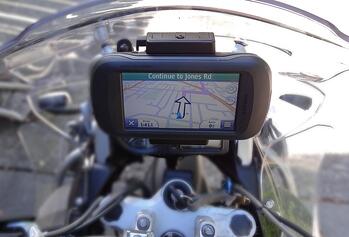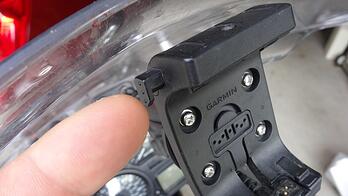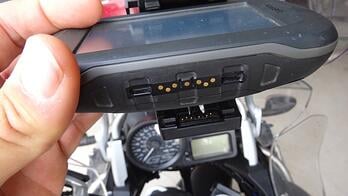 In the battle of the Best GPS for Motorcycle Trips, there are a few key reasons why I think it's easy to decide between the various options. As noted in my previous review of The Best Motorcycle GPS, Garmin's Montana GPS unit was a very clear winner amongst 3 other possibilities I tried, and I still think it's a great unit.
In the battle of the Best GPS for Motorcycle Trips, there are a few key reasons why I think it's easy to decide between the various options. As noted in my previous review of The Best Motorcycle GPS, Garmin's Montana GPS unit was a very clear winner amongst 3 other possibilities I tried, and I still think it's a great unit.
More specifically though, how do things play out when we ask "Garmin Montana vs. Oregon?"
Separate but similar designs, they both fall under Garmin's "On the Trail" category for hiking and backpacking types of GPS's. Both units also function with either AA battery or a proprietary NiMH battery that Garmin provides. Based on notions of versatility like this, both have gained popularity amongst motorcycle travelers as well as we continue to find ways to pack light, keep it simple, and not have to depend on nearby retail or shipping options. These GPS units are similar in size, weight, and usability thanks to a touch screen, and both are considered waterproof and extremely rugged for travel needs right out of the box.
In the end, however, these key points should make it obvious why the Montana wins against the Oregon for motorcycle travel:
 Mount Type: Do a Google search for "Garmin Oregon Mount" and you'll see pictures of how the unit "snaps" into a simple plastic mold and clasping roller. The problem there is that the integrated clasping roller actually that holds the Oregon is subject to the same bouncing and engine vibrations as the rest of the mold, such that the Oregon could and has popped loose while riding. - On the flipside, Garmin's "Rugged Mount" for the Montana has this separate mechanical switch shown in the picture to the right. By having the locking switch a separate assembly from the rest of the plastic unit, the switch is not subject to the same flexing and vibration that the rest of the mold deals with, and therefore doesn't accidentally pop open. (At least not thus far for me, even on rugged sections of non-paved riding in Patagonia.)
Mount Type: Do a Google search for "Garmin Oregon Mount" and you'll see pictures of how the unit "snaps" into a simple plastic mold and clasping roller. The problem there is that the integrated clasping roller actually that holds the Oregon is subject to the same bouncing and engine vibrations as the rest of the mold, such that the Oregon could and has popped loose while riding. - On the flipside, Garmin's "Rugged Mount" for the Montana has this separate mechanical switch shown in the picture to the right. By having the locking switch a separate assembly from the rest of the plastic unit, the switch is not subject to the same flexing and vibration that the rest of the mold deals with, and therefore doesn't accidentally pop open. (At least not thus far for me, even on rugged sections of non-paved riding in Patagonia.)
 Charging Method: Both the Montana and the Oregon can be charged by USB cables, which of course is great when you're connected to a wall, computer, or solar panel. The majority of your charging needs will probably be while riding, so for that, nothing beats the convenience of these electrical contacts that match up against Garmin's Rugged Mount. With the Oregon, you'll have to plug in/out the USB charging wire each time you get on/off the bike (for security reasons, if you don't want to leave it on the bike.) If for nothing other than saving time and avoiding monotony, the built-in exterior contacts on the Montana (shown right) are a huge convenience, as you can snap the Montana GPS into its place in 1-2 seconds. Charging begins when you turn the key then.
Charging Method: Both the Montana and the Oregon can be charged by USB cables, which of course is great when you're connected to a wall, computer, or solar panel. The majority of your charging needs will probably be while riding, so for that, nothing beats the convenience of these electrical contacts that match up against Garmin's Rugged Mount. With the Oregon, you'll have to plug in/out the USB charging wire each time you get on/off the bike (for security reasons, if you don't want to leave it on the bike.) If for nothing other than saving time and avoiding monotony, the built-in exterior contacts on the Montana (shown right) are a huge convenience, as you can snap the Montana GPS into its place in 1-2 seconds. Charging begins when you turn the key then.
Screen Size: No brainer here, "bigger is better" when you're looking through sunglasses and possibly a helmet face shield or goggles, trying to follow the route you're on. Not that the Oregon's 3" diagonal (7.6 cm) screen is awkwardly small, but compared to the 4" diagonal (10.2 cm) of the Montana, well...bigger is definitely better. Both units have a touch screen, which I've always found the most convenient and far less likely to have sun glare than the high-gloss screens of a unit like the Garmin 62s. In short, I've never really felt like I struggled to see the screen on the Montana, yet on the Oregon, maybe just a little.
Sure the Montana is slightly heavier (about 120 grams,) but when you've already got a 250-600lb motorcycle, that's hardly a difference. I know, every little bit adds up, but in this case, the choice is easy: Garmin's Montana wins again. (To learn more about item weight and packing your motorcycle gear, visit the linked article.)


